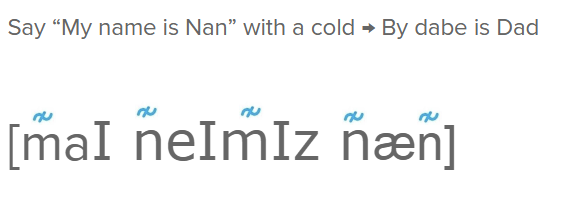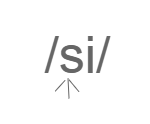Diacritics & Phonological Processes
1/40
There's no tags or description
Looks like no tags are added yet.
Name | Mastery | Learn | Test | Matching | Spaced |
|---|
No study sessions yet.
41 Terms
Nasalized (hypernasality)
Sound is produced with nasal resonance, “talking through your nose”
“Mean” —> [mĩn] (add ~ above phoneme that is nasalized)
Nasal Emission
When air escape through the nasal cavity
Nice —> nais͋ (put squiggle with two dots above)
Denasality (hyponasality )
Nasal phonemes are produced without nasalization (nasal passage is blocked like you have a cold)

Rounded Vowels
Say sweet, but keep your lips ROUNDED from the /w/
/swi̹t/ (backward “c” under phoneme)
Unrounded Vowels
Say “hue” but UNROUND “u” from /h/
/hu̜/ (forward “c” under phoneme)
Labialization
/u/ /ʊ/ /w/ —> may cause labialization
If a normally unrounded consonant-for example, a normally unrounded [s]-is produced with lip rounding, this is referred to as labializing the sound in question.
/kʷwIk/ (use a “w'“ next to the phoneme, indicating the rounding)
Dentalized (frontal lisp)
This term refers to an articulatory variation in which the tongue approaches the upper incisors.
Sue /s̪u/ NOT θu (half square under the dentalized phoneme)
Lateralized (lateral lisp)
/s/ and /z/ sound slushy
Zoo /z̯u/ (small half circle under /z/)
Derhotacized
Not quite an ‘r’ and not quite a ‘w’, “lazy r"‘
/͜ɹ ɛ d/ (half circle under the r losing)
/͜ɹ æbIt/
*mainer accent “lobstah”
Breathy
“air wastage'“, h-like noise
/pl ei̤ n/→ plane (two little dots under the breathy vowel)
Whistled
Sounds like a hiss noise
Happens mostly to fricatives
*arrow under whistled fricative

Palatalization
Articulators approach the palate for nonpalatized sounds
s and z more like “sh”
sʲue sounds like “shue”
Syllables
peak - most prominent, acoustically most intense part of the syllable
onset - all segments prior to the peak (typically a vowel)
coda - all sound segments following peak
rime - nucleus and coda
Open (unchecked) vs closed (checked) syllables
Open — do not contain codas (usually ends in a vowel)
Closed — contains codas (usually end in a consonant)
Syllable clinical significance
Children tend to use open syllables for their first words
Two syllable words tend to consist of two open syllables
Young chlidren may have restrictions on their syllable shapes
Phonotactic Assessment
The number of syllables a child uses
Whether the child uses a vowel as a nucleus of the syllable
the demonstration of both open and closed syllables
the use of consonant clusters
Length of word influence accuracy of speech
shorter words are easier for children
As words get longer, children tend to omit the unstressed syllables
Stress
As words get longer, children tend to omit the unstressed
Ease of syllable produced
Affected by:
The number of syllables in an utterance
The type of syllable (open vs closed)
Syllable stress
Optional: number of consonants grouped together
Syllable Structure Processes
Syllable Structure
Reduplication
Weak syllable deletion
Final consonant deletion
Cluster reduction
Epenthesis
Assimilation Patterns
Assimilation Patterns
Labial assimilation
Velar assimilation
Nasal assimilation
Liquid assimilation
Substitution Processes
Place of Articulation
Fronting
Labialization
Alveolarization
Manner
Stopping
Deaffrication
Gliding
Vowelization
Derhotacization
Voicing
Voicing
Devoicing
Reduplication
The second syllable becomes a repetition of the first
water —> wawa
Weak Syllable Deletion
An unstressed syllable is omitted
Banana —> nana
Final Consonant Deletion
A syllable arresting consonant (coda), or the final consonant is deleted
Head —> he
Cluster Reduction
The articulatory simplification of consonant clusters into a single consonant
Spoon —> poon
Epenthesis
Epenthesis is the insertion of a phoneme or syllable into a word
Blue —> ba-lue
Labial Assimilation
The change of a nonlabial sound into a labial sound under the influence of a neighboring labial sound
Swing —> fwing
Velar Assimilation
The change of a nonvelar sound into a velar sound under the influence of a neighboring velar sound
Dog —> gog
Nasal Assimilation
The influence of a nasal on a non-nasal sound
Bunny —> nuni
Liquid Assimilation
The influence of a liquid on a non-liquid sound
Yellow —> lello
Fronting
Sound substitutions in which the place of articulation is more anterior located than the intended sound
Key —> ti
Shoe —> su
Labialization
The replacement of a nonlabial sound for a labial one
Thumb —> fum
Alveolarization
The change of nonalveolar sounds, mostly interdental and labiodental sounds into alveolar ones
Thumb —> sum
Stopping
The substitution of stops for fricatives or the omission of the fricative portion of affricates
Sun —> tun
Deaffication
The production of affricates as fricatives
cheese —> sheez
Gliding
The replacement of liquids or fricatives by glides
Red —> wed
Vowelization
The replacement of syllabic liquids and nasals foremost l, er, and n by vowels
Table —> teibo
Derhotacization
The loss of r-coloring in central vowels with r coloring
Bird —> bed
Voicing
Replacement of a voiceless sound by a voiced sound
two —> du
Devoicing
The replacement of a voiced sound by a voiceless sound
Beet —> bit